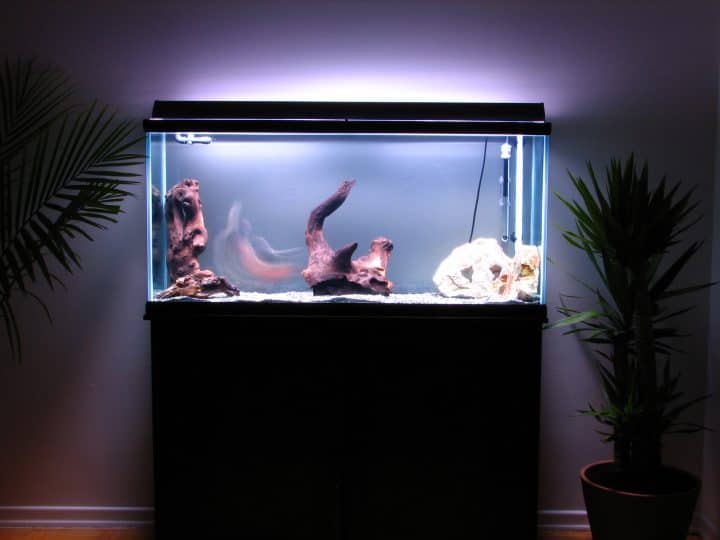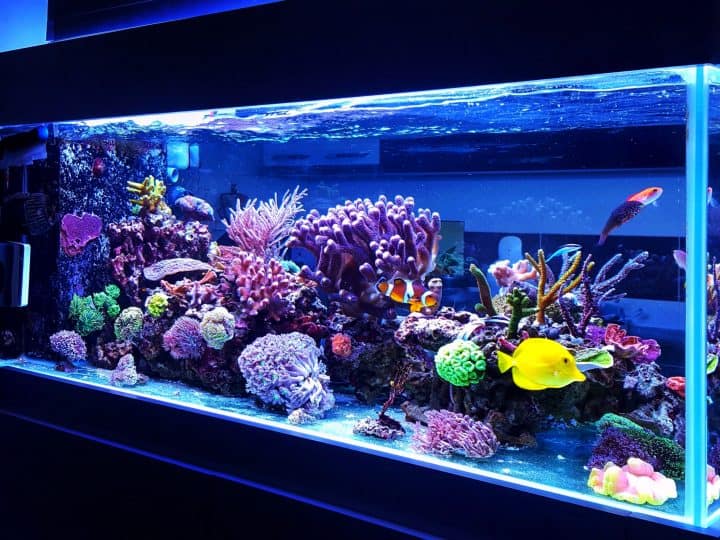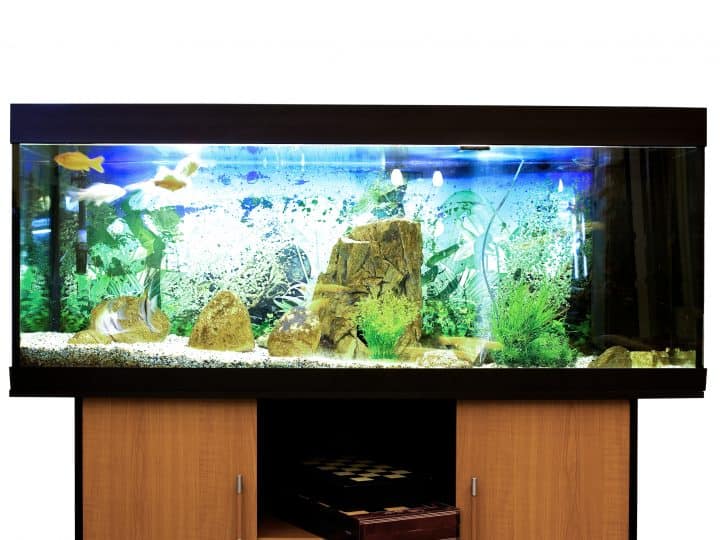If you’ve ever bought an aquarium before, you will know that just the glass of the empty tank can be quite heavy. I had to pick up one my aquariums with two strong friends of mine, which made me wonder how much they weight and what it takes to properly support them. A cheap cabinet can easily give in.
It is important that you do not underestimate the weight of a filled aquarium, because you need to properly support it to not risk leakage or any other damage. The following table will provide the estimated weights of a filled aquarium for all popular sizes.
| Size of the glass Aquarium | Approximate weight when filled |
| 10 gallon | 111 pounds |
| 20 gallon | 225 pounds |
| 30 gallon | 348 pounds |
| 55 gallon | 625 pounds |
| 65 gallon | 772 pounds |
| 90 gallon | 1050 pounds |
| 125 gallon | 1206 pounds |
| 150 gallon | 1838 pounds |
How much does an aquarium weight?
Firstly, what size aquarium are you buying? Generally, we go by 1 fish per gallon, of course, you can put a few more if your fish are small however bigger fish might need 2 to 3 gallons each. Using the same rule of thumb, adjust for the number you have or are planning to get.
Tip: If you are a beginner, remember that just because a tank is smaller does not mean it will be easier to take care of.
A 10-gallon aquarium on its own weighs about a 100 pounds, however, with gravel, rocks, air pump wood and other accessories it could weigh much more. A tank filled with saltwater also weighs more than a freshwater tank. Do not place any fish tank on a stool or a table as the legs can give out.
Do you need a dedicated aquarium stand?
When buying an aquarium, you should also consider getting an aquarium stand. Aquariums regardless of size or species of fish need to be perfectly level. When your tank is full of water and gravel it will be heavy and it needs strong support underneath.
The type of material the aquarium is made of will also make a difference. Acrylic is much lighter than glass so it needs support along the entire bottom of the tank. However, glass only needs support along the edges. It is advised to have full support for any aquarium.
It is a common practice to add a foam mat underneath the entirety of the aquarium to avoid pressure points and device the weight of the tank over the entire surface.
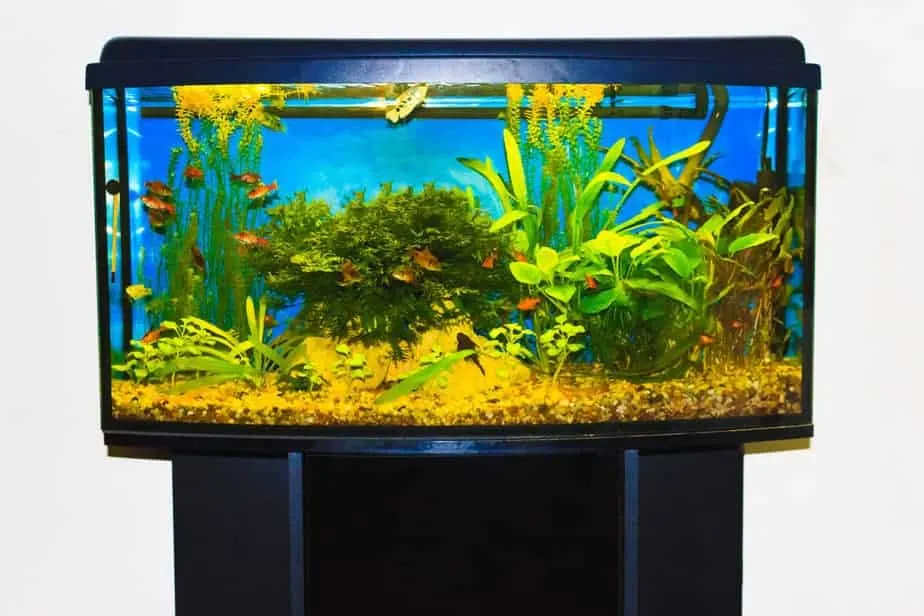
Cabinets and aquarium stands
For smaller tanks, a sturdy cabinet should be enough. The cabinet should be able to give full support. Do not use one that is narrower than the width of the tank as it may put additional stress on one side and cause leaks. Make sure you check what kind of wood the cabinet is as some woods swell when wet and can cause support issues.
If you are using a cabinet, you must also consider if the cords and filter can be placed behind it and that is easily accessible should you need to reach it for changes etc. Cabinets can easily be DIY-ed to make better aquarium stands.
Many inexperienced fish owners tend to place their aquarium on cheap IKEA-like cabinets which do not provide sufficient support and will give in over time. Cabinets can be reinforced using solid wood beams or metal. Most cabinets need only be reinforced on their joints or with metal braces. If in doubt get an aquarium stand as some cabinets can be made of lighter wood and can collapse under the weight.
If you have a tank bigger than 20 gallons, it is more secure to get an aquarium stand from the store where you bought the fish tank, online or even build one yourself. Cheaper aquarium stands can come from big stores with simple designs. There are better-trusted ones from branded stores and custom builds. Consider your budget before buying one as aquarium stands can be quite expensive.
There are many types of aquarium stands as well, made from metal or wood. Some stands are just enough to support the tank in the form of a simple-looking frame. While some stands can provide much more support as well as storage space to keep the fish food, cleaning supplies etc. For me, the extra storage space underneath proved to be useful to store all my aquarium equipment.
Make sure your floor can hold the weight
Can you put the tank on the floor? Yes, but you have to check whether your floor is strong enough. There are people who even put the aquarium inside of the floor to create an indoor pond. It can be difficult to clean as it is difficult to siphon water. It is generally advised only for experienced fish owners.
However, when your aquarium is too heavy and your floor to weak, you have to take measures. It is possible for your floor to collapse under the weight of the aquarium.
Different types of floors have different strengths. Stone flooring can come in the form of granite marble and even porcelain. They are durable and absorb less water. Laminate flooring is quite weak as well as other wood floorings. They are susceptible to scratches and dents and if underneath a tank may get water damage. Carpeted flooring is also not advised as it will be difficult to clean. It can also create harmful bacteria if mould grows on it. Plain tiles can also cause problems as they need to be grouted to clean.
Even more important than the type of floor you have added is the structural integrity of your house. Check with your building manager and other building codes about what kind of floor you have and exactly how much weight it can hold. This is really important for people who plan to place big aquariums in a house with wooden floors. The best floors are made of solid concrete and have a proper foundation.
If your floor is not strong enough It can be reinforced using floor jacks and a few planks of woods. Contact an engineer or contractor if you prefer not to do it yourself, they may have a better understanding of what kind of cross beams and/or studs might be required to strengthen the floor.
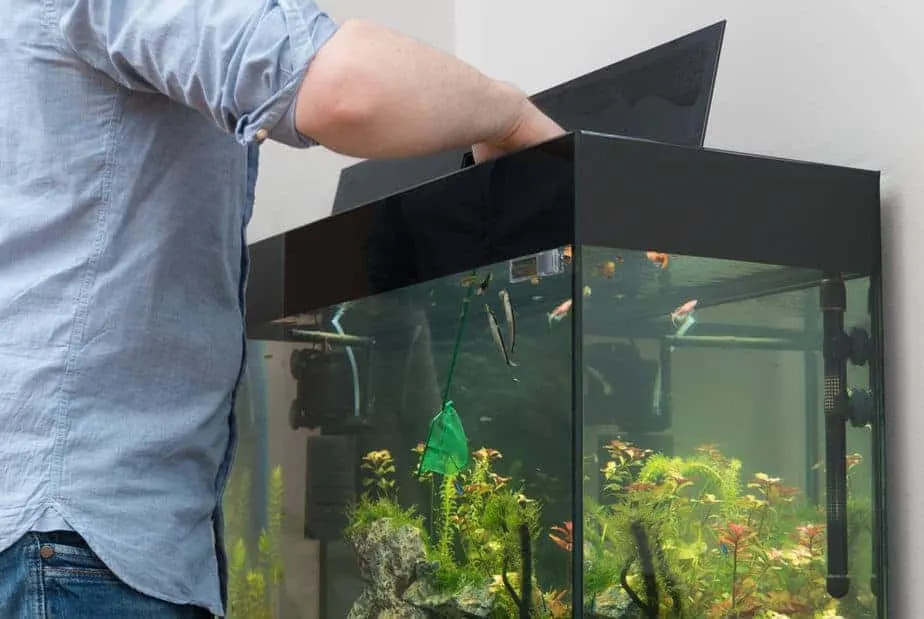
Custom aquarium builds
Aquariums have become much more trendy and you might want a cool aquarium in your house like a tall round aquarium or one with fancy lighting and mounted on the wall. As long as the custom build is very strong and secure, aquariums can be placed almost anywhere. Aquariums can also come in multiple shapes from the store. While the rectangle is the most common, there are hexagon, corner half land half water aquariums.
Half Land half water aquariums are also known as paludarium, they can be used to put plants and fish together as well as more exotic species of fish like mudskippers and amphibians used to water land type of environments, like mangroves. Especially these types of aquariums can be very heavy as they have many parts including the water gravel and substrate.
Correct placement of your aquarium
Once you get your aquarium and your desired stand, make sure you avoid placing it near direct sunlight. Fish can react badly to sudden temperature changes so don’t put it near a radiator or air conditioner. While the filter and light need to be plugged in make sure the tank is still a decent distance away from wall sockets.
It is a good idea to put the tank in a common or main area where you can see them and check for sudden changes in behavior or leaks. While it is not exactly known how much sound can affect your fish, it is better to keep the tank away from any subwoofer or large speakers.
Some popular aquarium dimensions
Aquariums come most commonly in rectangle fish tanks, however they can be custom built to many different shapes. Standard sizes from stores tend to be dimensions of 22” x 12” x 13.5” for a 10 gallon aquarium for freshwater fish. Saltwater fish tend to need larger tanks so about 36″ x 18″ x 12″ for a 30 gallon tank. Aquariums are usually distinguished by volume of water. They can also be classified as breeder and regular tanks.
Breeder tanks usually have more surface and a shorter height even if it holds the same volume of water. Beginners are advised to start with a medium size fish tank as it is easier to monitor water conditions, pH, nitrogen cycle etc in a bigger tank than its is in a smaller tank.
Other things to remember when looking to get an aquarium
Aquariums can be very heavy even the smaller ones, check that what you are using to put the fish tank on is strong or reinforce if needed. Consider budget, materials, placement and future expansion when deciding where to keep your aquarium. It is always better to go for something that can carry a much larger amount of weight than to risk setting the aquarium on something that could collapse.


